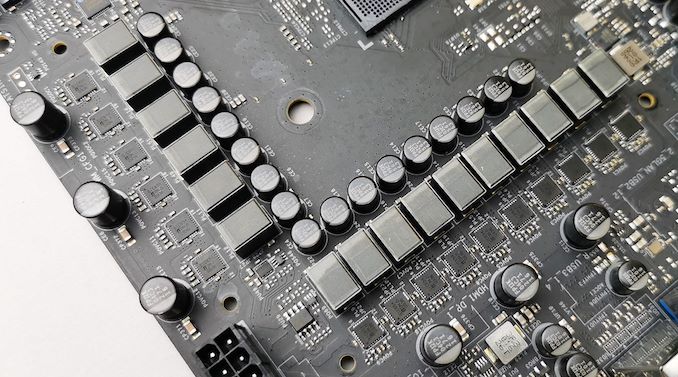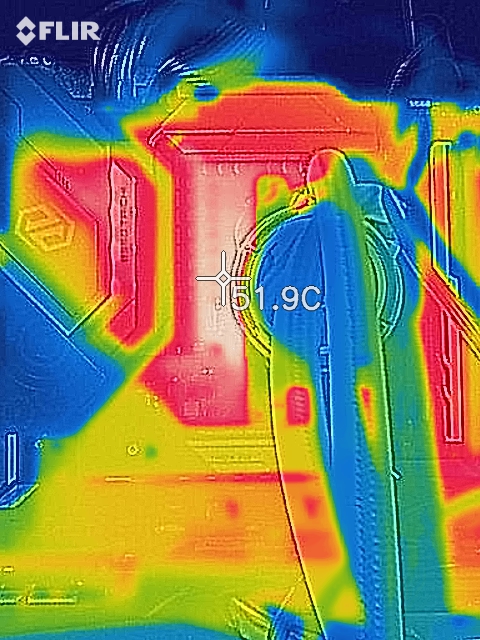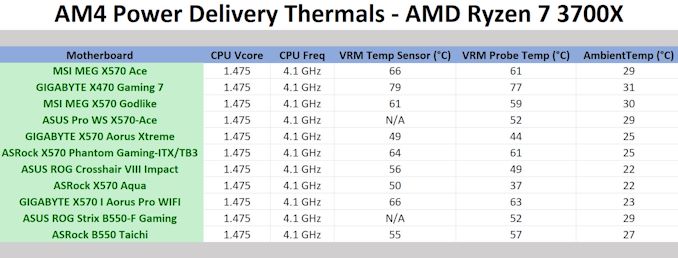ASRock B550 Taichi Review: The $300 B550 Motherboard with Chutzpah
by Gavin Bonshor on August 21, 2020 3:30 PM EST- Posted in
- Motherboards
- AMD
- ASRock
- Taichi
- AM4
- Ryzen 3000
- Ryzen 3700X
- Ryzen 4000
- B550
- B550 Taichi
Power Delivery Thermal Analysis
One of the most requested elements of our motherboard reviews revolves around the power delivery and its componentry. Aside from the quality of the components and its capability for overclocking to push out higher clock speeds which in turn improves performance, is the thermal capability of the cooling solutions implemented by manufacturers. While almost always fine for users running processors at default settings, the cooling capability of the VRMs isn't something that users should worry too much about, but for those looking to squeeze out extra performance from the CPU via overclocking, this puts extra pressure on the power delivery and in turn, generates extra heat. This is why more premium models often include heatsinks on its models with better cooling designs, heftier chunks of metal, and in some cases, even with water blocks.

The 16-phase power delivery operating at 7+1 on the ASRock B550 Taichi
Testing Methodology
Out method of testing out if the power delivery and its heatsink are effective at dissipating heat, is by running an intensely heavy CPU workload for a prolonged method of time. We apply an overclock which is deemed safe and at the maximum that the silicon on our AMD Ryzen 7 3700X processor allows. We then run the Prime95 with AVX2 enabled under a torture test for an hour at the maximum stable overclock we can which puts insane pressure on the processor. We collect our data via three different methods which include the following:
- Taking a thermal image from a birds-eye view after an hour with a Flir Pro thermal imaging camera
- Securing two probes on to the rear of the PCB, right underneath CPU VCore section of the power delivery for better parity in case the first probe reports a faulty reading
- Taking a reading of the VRM temperature from the sensor reading within the HWInfo monitoring application
The reason for using three different methods is that some sensors can read inaccurate temperatures, which can give very erratic results for users looking to gauge whether an overclock is too much pressure for the power delivery handle. With using a probe on the rear, it can also show the efficiency of the power stages and heatsinks as a wide margin between the probe and sensor temperature can show that the heatsink is dissipating heat and that the design is working, or that the internal sensor is massively wrong. To ensure our probe was accurate before testing, I binned 10 and selected the most accurate (within 1c of the actual temperature) for better parity in our testing.
For thermal image, we use a Flir One camera as it gives a good indication of where the heat is generated around the socket area, as some designs use different configurations and an evenly spread power delivery with good components will usually generate less heat. Manufacturers who use inefficient heatsinks and cheap out on power delivery components should run hotter than those who have invested. Of course, a $700 flagship motherboard is likely to outperform a cheaper $100 model under the same testing conditions, but it is still worth testing to see which vendors are doing things correctly.
Thermal Analysis Results

We measured 51.9°C on the hottest part of CPU socket area during our testing
The ASRock B550 Taichi is using a 16-phase design which is operating in a 7+1 configuration with an Intersil ISL229004 8-phase PWM controller. It is using fourteen Vishay SiC654 50 A power stages for the CPU and two SiC654 50 A power stages for the SoC. The CPU section is using seven ISL6617A doublers, while the SoC section is using a single ISL6617A doubler which makes the B550 Taichi's power delivery a 7+1 design. The power delivery is cooled by a pair of heatsinks connected by a single heat pipe which relies on passive airflow within a chassis.
In our power delivery thermal testing, the ASRock B550 Taichi performs quite well against other AM4 boards on test. Our testing shows that the Taichi's 16-phase design is rather efficient, which puts it ahead of some high-end X570 models which is impressive. The Taichi includes a dedicated temperature sensor for the power delivery which in our testing displayed a reading of 55°C, while our K-type probe mounted to the rear of the power delivery measured a reading of 57°C. Using our FLIR thermal imaging camera, we measured a 51.9°C on the hottest part of the CPU socket area, which shows that the cooling properties of the heatsink is efficient at dissipating heat. For a B550 motherboard, the results are competitive, and that the ASRock B550 Taichi is a very competent board for overclocking.











61 Comments
View All Comments
dromoxen - Tuesday, August 25, 2020 - link
How do you connect your endpoints directly ? I would like 2.5gb for my next purch but lack of cheapish switches is a stumbling block ... 2500K needs retiring ..Or do I wait for ??Gigaplex - Wednesday, August 26, 2020 - link
My file server has 2 ethernet ports. I connect my desktop to my file server directly with an ethernet cable using the 2.5G port, and use the other ethernet port on the server to the rest of my network. The network connections are bridged on the server, so the desktop can see the rest of the network.Spunjji - Monday, August 24, 2020 - link
"Why 2.5GbE" - because some people keep their boards a long time, 1GbE is pretty slow for NAS storage needs and the kind of person spending $300 on a motherboard probably isn't going to use their ISP's router as their main switch?Most ISP routers aren't WiFi 6 yet either, so it's weird that you think *that* makes sense but not the 2.5GbE.
You've arbitrarily stated a "maximum price" for B550 that seems more appropriate for B520.
xrror - Monday, August 24, 2020 - link
Of all of the possible things to complain about, you pick having onboard 2.5GB NIC?I mean, it just seems a strange choice as a complaint?
TheinsanegamerN - Tuesday, August 25, 2020 - link
By that argument most motherboards shouldnt even have gigabit, but rather fast ethernet 100 Mbps.seamonkey79 - Sunday, August 23, 2020 - link
This is as stupid as paying $100 extra for a AIO with a screen on the waterblock.Greys - Wednesday, August 26, 2020 - link
CoolOxford Guy - Wednesday, August 26, 2020 - link
Yes, it’s cool to parlay a midrange chipset at a premium price point.Why? Who knows!
Everett F Sargent - Thursday, August 27, 2020 - link
"Yes, it’s cool to parlay a midrange chipset at a premium price point.Why? Who knows!"
Try this B550 board ...
https://www.gigabyte.com/Motherboard/B550-AORUS-MA...
If I wanted a 16-phase Voltage Regulator AND an MSRP below $300US ($280US) this looks like a pretty good option. I also am not into OC or gaming, so that I am fine with a very cheap graphics card running 8X and three M.2 PCIE 4.0 SSD's in RAID0 and a 3950X running stock. I'll also use ECC memory as this thing will be running all 32-threads 247 for weeks on end.
Plugin two (or one) additional PCIE 4.0 M.2's, the GPU is set to x8 instead of x16
So the question is, is there anything out there (AMD) that is available for a lower MSRP cost that has, at a minimum, a 16-phase Voltage Regulator? TIA
Oh and if you have a better solution for whatever reason(s) that would also be most useful.
I think the MB vendors know what they are doing, there appears to be no MSRP price overlap for comparable feature sets. Still trying to find an X570 that will do all that this MB can do at a lower MSRP price point.
I'm thinking of using this MB as a sort of test bed for my own numerical modelling codes (do I really need RAID 0 for I/O, RAM requirements and possibly some OC (depends on % improvement and temperatures, but gaining only a few percent seems to be rather pointless. which appears to be the current situation, I need more threads not a small % MHz improvement).
Oxford Guy - Tuesday, September 1, 2020 - link
I already said the VRM marketing pitch falls flat because these CPUs shouldn't even be overclocked.It's a gimmick and it flunks.